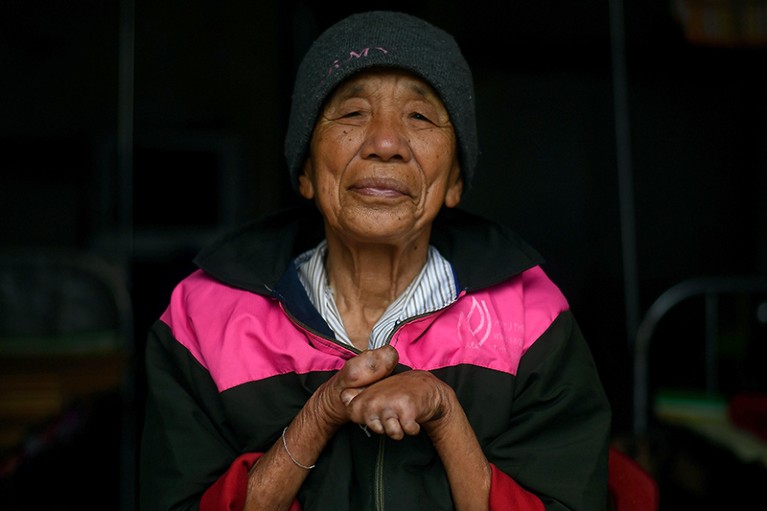
Leprosy survivor Nguyen Van Phuc at the Van Mon Leprosy hospice compound in Thai Binh, Vietnam.Credit: Manan Vatsyayana/AFP/Getty
No Matter Where the Journey Takes Me: One Man’s Quest for a Leprosy-Free World Yohei Sasakawa Hurst (2019)
Leprosy is one of the oldest recorded diseases. Caused by the bacillus Mycobacterium leprae, it has affected multitudes over thousands of years — and, as a chronic disease with physical manifestations, has been a source of stigma and ostracism. Philanthropist Yohei Sasakawa, a passionate advocate for people with leprosy, calls it “the oldest continuing human rights issue in the history of mankind”.
Sasakawa’s book No Matter Where the Journey Takes Me is a moving account of efforts over almost 60 years to fight both disease and discrimination. Despite significant work, an estimated 3 million people around the world are living with disability from leprosy. The book is a rallying cry for a world free of this disease.
Sasakawa begins by recounting how, in his twenties, he saw his father extend his hand to a man infected with leprosy. That set the seed for his personal commitment to vanquishing the disease, which led him to found the Sasakawa India Leprosy Foundation in New Delhi. He is also both the World Health Organization (WHO) Goodwill Ambassador for Leprosy Elimination, and Japan’s Goodwill Ambassador for the Human Rights of Persons Affected by Leprosy.
Set against a vividly described backdrop spanning the Second World War, the cold war and more recent decades, Sasakawa takes his readers around the world and into conversations with figures as diverse as Pope John Paul II and the Cuban ambassador to the United Nations in Geneva, Switzerland. He offers fascinating insights into what it takes to put the disease onto the agendas of decision-makers worldwide, and why positioning leprosy as a human-rights issue as well as a health challenge similar to malaria or HIV has been so effective.
Leprosy incubates slowly, affecting the skin, upper respiratory tract, eyes and peripheral nerves. The damage to nerve endings can cause an inability to feel pain; if unchecked, ulcers and infection can shorten digits or even lead to amputation of hands or feet. Harking back to his early encounters with people who had the illness in the 1960s, Sasakawa unapologetically highlights the disability experienced by infected people, recounting how at a specialized Korean hospital he saw many people with severe damage to their extremities and faces. What shocked him most, he writes, was their expressions: “as though they had long let the life-blood drain from their bodies out of despair”.
Since multidrug therapy (MDT) was introduced in the 1980s, Sasakawa’s Tokyo-based Nippon Foundation, working in conjunction with the WHO, has provided millions of doses free of charge globally. The period from 1995 to 1999 became a crucial turning point, allowing people with the condition to be diagnosed early and treated promptly, and so preventing the onset of avoidable disability. From the turn of the millennium, the Novartis Foundation in Basel, Switzerland, which I direct, has taken over the MDT donations in agreement with the WHO. More than 16 million people have now been treated with MDT, which takes six months to a year to effect a cure.
As the book makes clear, a highly committed community and a global approach to tackling the disease were paramount to the successful screening, diagnosis and treatment effort that reduced the global leprosy burden by more than 99%. However, for more than a decade, the number of people diagnosed each year has remained stable at more than 200,000 — including thousands of children. And because millions still cope with related disability, the fear of stigma (especially in the countries where most cases occur, such as Brazil, India and Indonesia) remains a major barrier to the prompt diagnosis and treatment required to interrupt transmission once and for all. So, although the number of people with leprosy has declined, Sasakawa explains that the disease will be vanquished only when “the number of people who discriminate against people affected by the disease also diminishes”.
After reading Sasakawa’s powerful account, I am confident that we will consign leprosy to history. New approaches using artificial intelligence and efforts to develop reliable diagnostic tests are complemented by innovative screening initiatives and prevention. In contact tracing, for instance, all people in persistent contact with a newly diagnosed individual are tracked down and offered appropriate preventive drugs.
Careful efforts to record and share people’s experiences are central to this effort. Sasakawa summarizes his commitment perfectly, saying that wherever he goes, he has “consistently conveyed three simple messages: that leprosy is curable, that treatment is free, and that it is wrong to discriminate”. He hopes that when ‘zero leprosy’ is reached, the quest to eradicate it is not forgotten. No Matter Where the Journey Takes Me, as the record of a life lived in the thick of the quest, will help to ensure that.

 Pioneer of polio eradication
Pioneer of polio eradication
 Journal of the plague years
Journal of the plague years








